Analysis of Management Functions and Organizational Structure Report
VerifiedAdded on 2021/04/21
|10
|2290
|64
Report
AI Summary
This report examines key management functions, organizational structures, and communication strategies within the context of a family cleaning service business. It begins by outlining the four core functions of management: planning, organizing, leading, and controlling, detailing how each applies to the cleaning service. The report then analyzes different organizational structures, including sole proprietorship, partnerships, and corporations, assessing their benefits and relevance to achieving business goals. Furthermore, it explores Handy's person culture model, emphasizing the importance of skilled workers and customer satisfaction in achieving business objectives. Finally, the report addresses effective communication strategies, such as choosing the right atmosphere, avoiding obstacles, active listening, and detachment, to ensure successful internal and external interactions. The analysis includes references to relevant academic sources.
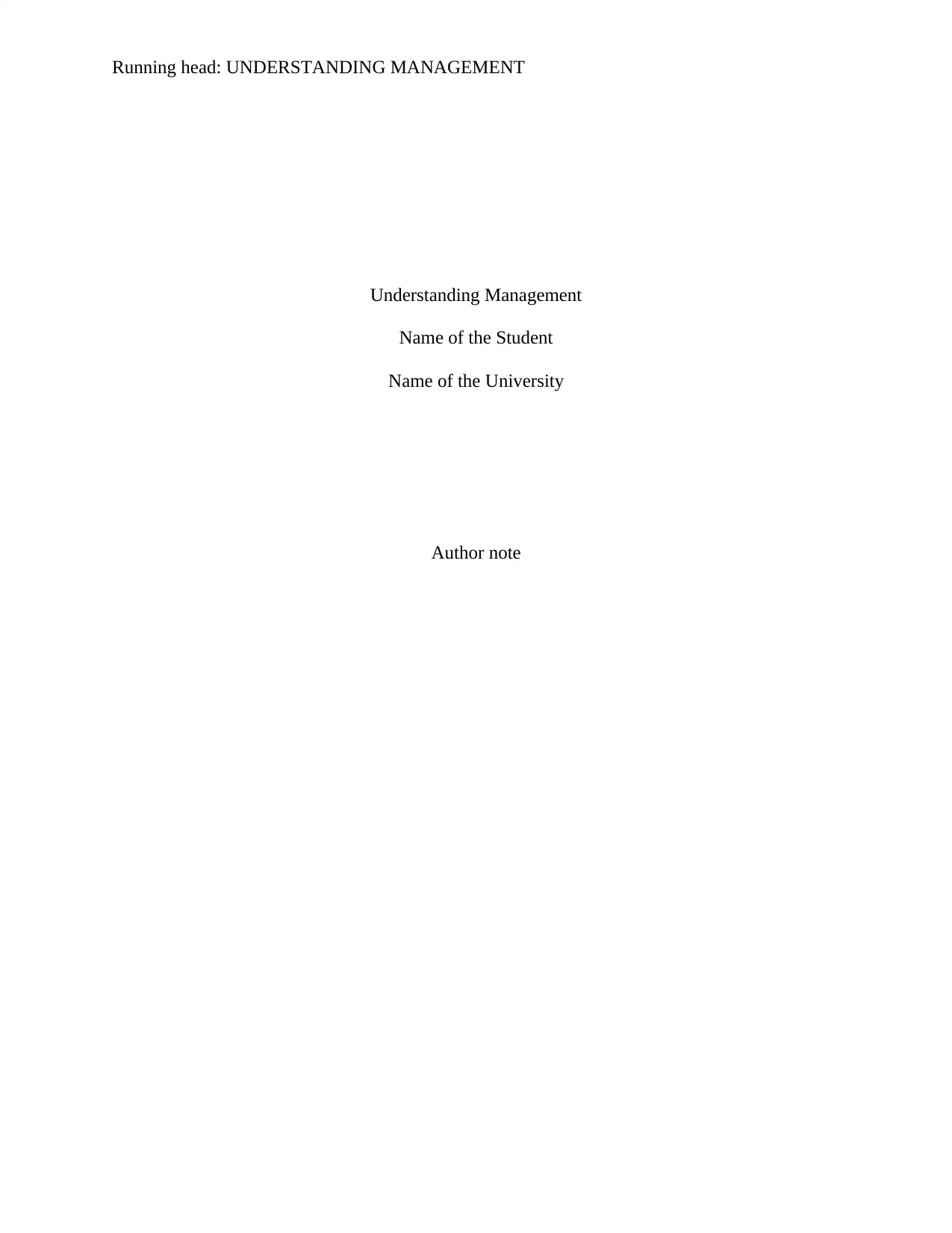
Running head: UNDERSTANDING MANAGEMENT
Understanding Management
Name of the Student
Name of the University
Author note
Understanding Management
Name of the Student
Name of the University
Author note
Paraphrase This Document
Need a fresh take? Get an instant paraphrase of this document with our AI Paraphraser

1UNDERSTANDING MANAGEMENT
Table of Contents
Task 1...............................................................................................................................................2
Task 2...............................................................................................................................................3
Task 3...............................................................................................................................................4
Task 4...............................................................................................................................................4
References........................................................................................................................................6
Table of Contents
Task 1...............................................................................................................................................2
Task 2...............................................................................................................................................3
Task 3...............................................................................................................................................4
Task 4...............................................................................................................................................4
References........................................................................................................................................6

2UNDERSTANDING MANAGEMENT
Task 1
The four functions of management approach for the business activities are given in the
following paragraph.
The first function is planning where goals and objectives are developed, and determined
how it will be accomplished for the better functioning of the business. The planning for cleaning
services businesses includes objectives and goals and they are as follows. The first goal is to
retain existing customers and attract new customers by satisfying customer’s expectations in the
business (Albrecht et al. 2015). The second goal is to develop a sustainable business for home,
offices and commercial services that will provide better revenue. The third goal is to provide the
clients with all the cleaning services for home, offices and commercial purposes. The second
function is organizing where planning is organized with internal structure of the organization
including managers and employees. The organizing is done hierarchically in an organization
where manager sets goals and objectives. The organizing in the cleaning service business is
given as follows. The goals and objectives in planning function are developed including
resources and staff of the organization. The manager should divide the responsibilities of
business services to employees. The employees should be assigned responsibilities according to
their skills and knowledge. The organization should use technologies to ease the process of
business functions. The advanced cleaning technologies should be used for better performance of
the business functions (Birkinshaw and Ansari 2015). The online advertisement of the business
should also be given to reach the large group of customers. The third function is leading where
direction is given to the staff for managing and controlling the working environment. The
characteristics of giving direction to staff in the cleaning service business are given as follows.
The first characteristic is persuasive function where manager of cleaning service business should
Task 1
The four functions of management approach for the business activities are given in the
following paragraph.
The first function is planning where goals and objectives are developed, and determined
how it will be accomplished for the better functioning of the business. The planning for cleaning
services businesses includes objectives and goals and they are as follows. The first goal is to
retain existing customers and attract new customers by satisfying customer’s expectations in the
business (Albrecht et al. 2015). The second goal is to develop a sustainable business for home,
offices and commercial services that will provide better revenue. The third goal is to provide the
clients with all the cleaning services for home, offices and commercial purposes. The second
function is organizing where planning is organized with internal structure of the organization
including managers and employees. The organizing is done hierarchically in an organization
where manager sets goals and objectives. The organizing in the cleaning service business is
given as follows. The goals and objectives in planning function are developed including
resources and staff of the organization. The manager should divide the responsibilities of
business services to employees. The employees should be assigned responsibilities according to
their skills and knowledge. The organization should use technologies to ease the process of
business functions. The advanced cleaning technologies should be used for better performance of
the business functions (Birkinshaw and Ansari 2015). The online advertisement of the business
should also be given to reach the large group of customers. The third function is leading where
direction is given to the staff for managing and controlling the working environment. The
characteristics of giving direction to staff in the cleaning service business are given as follows.
The first characteristic is persuasive function where manager of cleaning service business should
⊘ This is a preview!⊘
Do you want full access?
Subscribe today to unlock all pages.

Trusted by 1+ million students worldwide
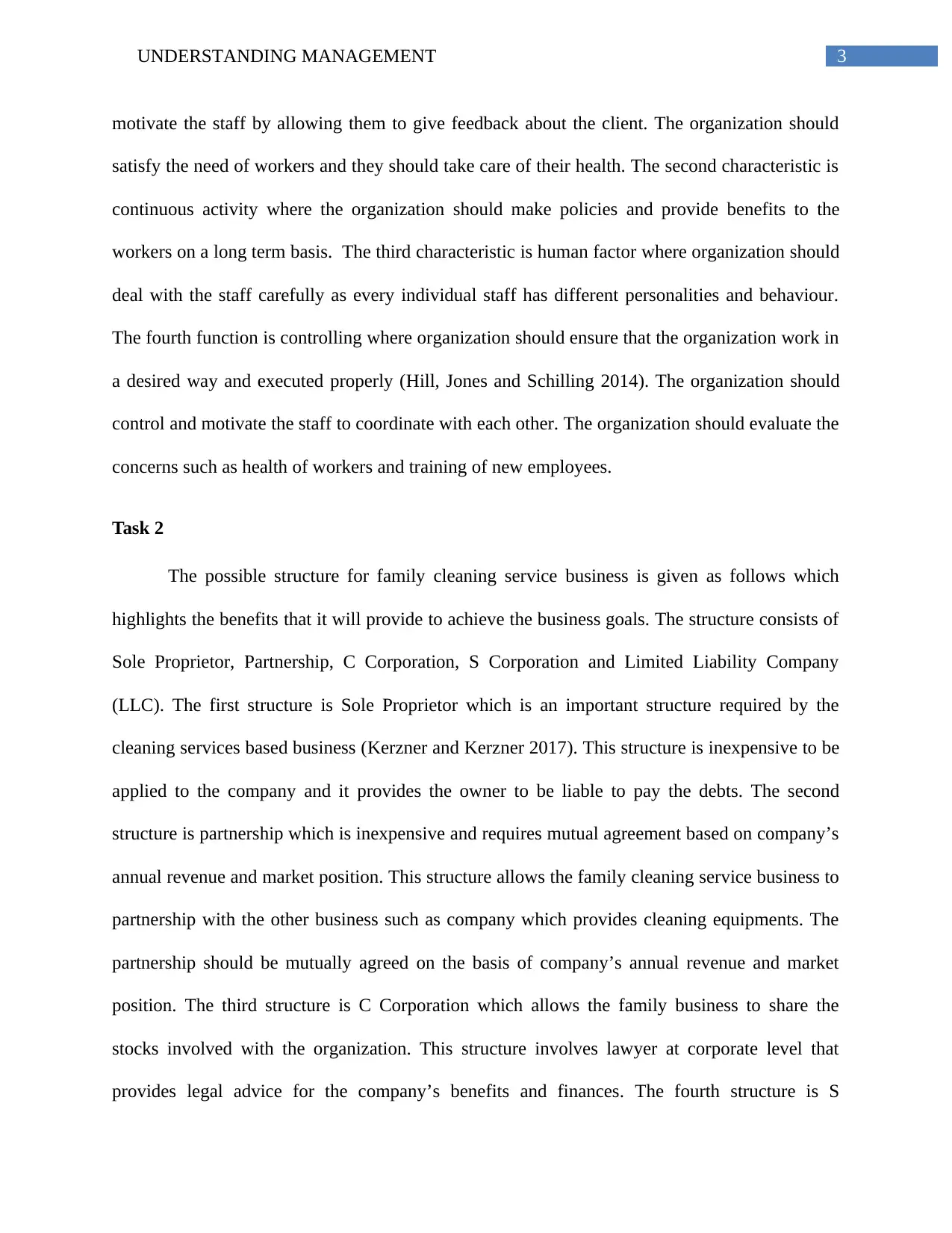
3UNDERSTANDING MANAGEMENT
motivate the staff by allowing them to give feedback about the client. The organization should
satisfy the need of workers and they should take care of their health. The second characteristic is
continuous activity where the organization should make policies and provide benefits to the
workers on a long term basis. The third characteristic is human factor where organization should
deal with the staff carefully as every individual staff has different personalities and behaviour.
The fourth function is controlling where organization should ensure that the organization work in
a desired way and executed properly (Hill, Jones and Schilling 2014). The organization should
control and motivate the staff to coordinate with each other. The organization should evaluate the
concerns such as health of workers and training of new employees.
Task 2
The possible structure for family cleaning service business is given as follows which
highlights the benefits that it will provide to achieve the business goals. The structure consists of
Sole Proprietor, Partnership, C Corporation, S Corporation and Limited Liability Company
(LLC). The first structure is Sole Proprietor which is an important structure required by the
cleaning services based business (Kerzner and Kerzner 2017). This structure is inexpensive to be
applied to the company and it provides the owner to be liable to pay the debts. The second
structure is partnership which is inexpensive and requires mutual agreement based on company’s
annual revenue and market position. This structure allows the family cleaning service business to
partnership with the other business such as company which provides cleaning equipments. The
partnership should be mutually agreed on the basis of company’s annual revenue and market
position. The third structure is C Corporation which allows the family business to share the
stocks involved with the organization. This structure involves lawyer at corporate level that
provides legal advice for the company’s benefits and finances. The fourth structure is S
motivate the staff by allowing them to give feedback about the client. The organization should
satisfy the need of workers and they should take care of their health. The second characteristic is
continuous activity where the organization should make policies and provide benefits to the
workers on a long term basis. The third characteristic is human factor where organization should
deal with the staff carefully as every individual staff has different personalities and behaviour.
The fourth function is controlling where organization should ensure that the organization work in
a desired way and executed properly (Hill, Jones and Schilling 2014). The organization should
control and motivate the staff to coordinate with each other. The organization should evaluate the
concerns such as health of workers and training of new employees.
Task 2
The possible structure for family cleaning service business is given as follows which
highlights the benefits that it will provide to achieve the business goals. The structure consists of
Sole Proprietor, Partnership, C Corporation, S Corporation and Limited Liability Company
(LLC). The first structure is Sole Proprietor which is an important structure required by the
cleaning services based business (Kerzner and Kerzner 2017). This structure is inexpensive to be
applied to the company and it provides the owner to be liable to pay the debts. The second
structure is partnership which is inexpensive and requires mutual agreement based on company’s
annual revenue and market position. This structure allows the family cleaning service business to
partnership with the other business such as company which provides cleaning equipments. The
partnership should be mutually agreed on the basis of company’s annual revenue and market
position. The third structure is C Corporation which allows the family business to share the
stocks involved with the organization. This structure involves lawyer at corporate level that
provides legal advice for the company’s benefits and finances. The fourth structure is S
Paraphrase This Document
Need a fresh take? Get an instant paraphrase of this document with our AI Paraphraser
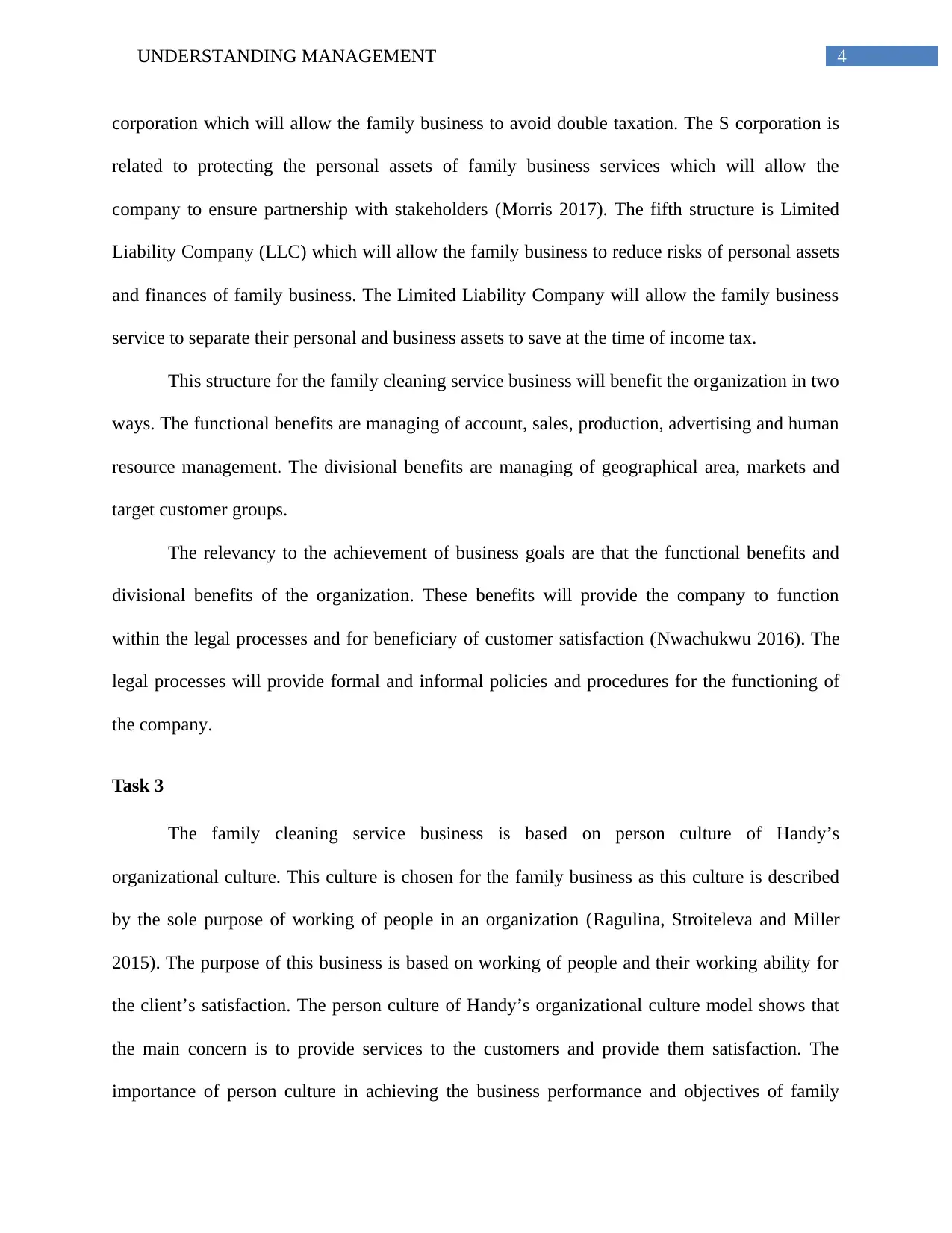
4UNDERSTANDING MANAGEMENT
corporation which will allow the family business to avoid double taxation. The S corporation is
related to protecting the personal assets of family business services which will allow the
company to ensure partnership with stakeholders (Morris 2017). The fifth structure is Limited
Liability Company (LLC) which will allow the family business to reduce risks of personal assets
and finances of family business. The Limited Liability Company will allow the family business
service to separate their personal and business assets to save at the time of income tax.
This structure for the family cleaning service business will benefit the organization in two
ways. The functional benefits are managing of account, sales, production, advertising and human
resource management. The divisional benefits are managing of geographical area, markets and
target customer groups.
The relevancy to the achievement of business goals are that the functional benefits and
divisional benefits of the organization. These benefits will provide the company to function
within the legal processes and for beneficiary of customer satisfaction (Nwachukwu 2016). The
legal processes will provide formal and informal policies and procedures for the functioning of
the company.
Task 3
The family cleaning service business is based on person culture of Handy’s
organizational culture. This culture is chosen for the family business as this culture is described
by the sole purpose of working of people in an organization (Ragulina, Stroiteleva and Miller
2015). The purpose of this business is based on working of people and their working ability for
the client’s satisfaction. The person culture of Handy’s organizational culture model shows that
the main concern is to provide services to the customers and provide them satisfaction. The
importance of person culture in achieving the business performance and objectives of family
corporation which will allow the family business to avoid double taxation. The S corporation is
related to protecting the personal assets of family business services which will allow the
company to ensure partnership with stakeholders (Morris 2017). The fifth structure is Limited
Liability Company (LLC) which will allow the family business to reduce risks of personal assets
and finances of family business. The Limited Liability Company will allow the family business
service to separate their personal and business assets to save at the time of income tax.
This structure for the family cleaning service business will benefit the organization in two
ways. The functional benefits are managing of account, sales, production, advertising and human
resource management. The divisional benefits are managing of geographical area, markets and
target customer groups.
The relevancy to the achievement of business goals are that the functional benefits and
divisional benefits of the organization. These benefits will provide the company to function
within the legal processes and for beneficiary of customer satisfaction (Nwachukwu 2016). The
legal processes will provide formal and informal policies and procedures for the functioning of
the company.
Task 3
The family cleaning service business is based on person culture of Handy’s
organizational culture. This culture is chosen for the family business as this culture is described
by the sole purpose of working of people in an organization (Ragulina, Stroiteleva and Miller
2015). The purpose of this business is based on working of people and their working ability for
the client’s satisfaction. The person culture of Handy’s organizational culture model shows that
the main concern is to provide services to the customers and provide them satisfaction. The
importance of person culture in achieving the business performance and objectives of family
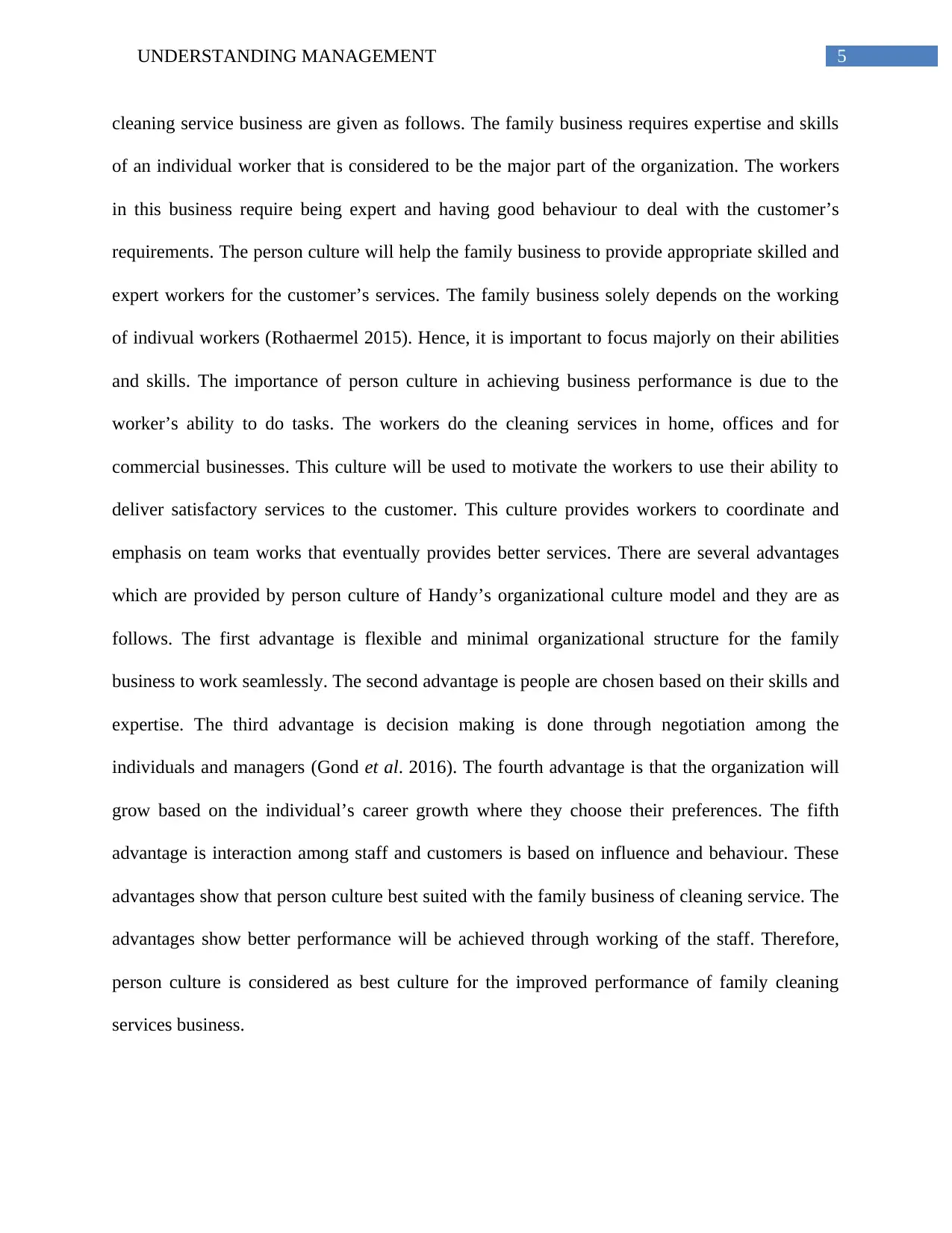
5UNDERSTANDING MANAGEMENT
cleaning service business are given as follows. The family business requires expertise and skills
of an individual worker that is considered to be the major part of the organization. The workers
in this business require being expert and having good behaviour to deal with the customer’s
requirements. The person culture will help the family business to provide appropriate skilled and
expert workers for the customer’s services. The family business solely depends on the working
of indivual workers (Rothaermel 2015). Hence, it is important to focus majorly on their abilities
and skills. The importance of person culture in achieving business performance is due to the
worker’s ability to do tasks. The workers do the cleaning services in home, offices and for
commercial businesses. This culture will be used to motivate the workers to use their ability to
deliver satisfactory services to the customer. This culture provides workers to coordinate and
emphasis on team works that eventually provides better services. There are several advantages
which are provided by person culture of Handy’s organizational culture model and they are as
follows. The first advantage is flexible and minimal organizational structure for the family
business to work seamlessly. The second advantage is people are chosen based on their skills and
expertise. The third advantage is decision making is done through negotiation among the
individuals and managers (Gond et al. 2016). The fourth advantage is that the organization will
grow based on the individual’s career growth where they choose their preferences. The fifth
advantage is interaction among staff and customers is based on influence and behaviour. These
advantages show that person culture best suited with the family business of cleaning service. The
advantages show better performance will be achieved through working of the staff. Therefore,
person culture is considered as best culture for the improved performance of family cleaning
services business.
cleaning service business are given as follows. The family business requires expertise and skills
of an individual worker that is considered to be the major part of the organization. The workers
in this business require being expert and having good behaviour to deal with the customer’s
requirements. The person culture will help the family business to provide appropriate skilled and
expert workers for the customer’s services. The family business solely depends on the working
of indivual workers (Rothaermel 2015). Hence, it is important to focus majorly on their abilities
and skills. The importance of person culture in achieving business performance is due to the
worker’s ability to do tasks. The workers do the cleaning services in home, offices and for
commercial businesses. This culture will be used to motivate the workers to use their ability to
deliver satisfactory services to the customer. This culture provides workers to coordinate and
emphasis on team works that eventually provides better services. There are several advantages
which are provided by person culture of Handy’s organizational culture model and they are as
follows. The first advantage is flexible and minimal organizational structure for the family
business to work seamlessly. The second advantage is people are chosen based on their skills and
expertise. The third advantage is decision making is done through negotiation among the
individuals and managers (Gond et al. 2016). The fourth advantage is that the organization will
grow based on the individual’s career growth where they choose their preferences. The fifth
advantage is interaction among staff and customers is based on influence and behaviour. These
advantages show that person culture best suited with the family business of cleaning service. The
advantages show better performance will be achieved through working of the staff. Therefore,
person culture is considered as best culture for the improved performance of family cleaning
services business.
⊘ This is a preview!⊘
Do you want full access?
Subscribe today to unlock all pages.

Trusted by 1+ million students worldwide
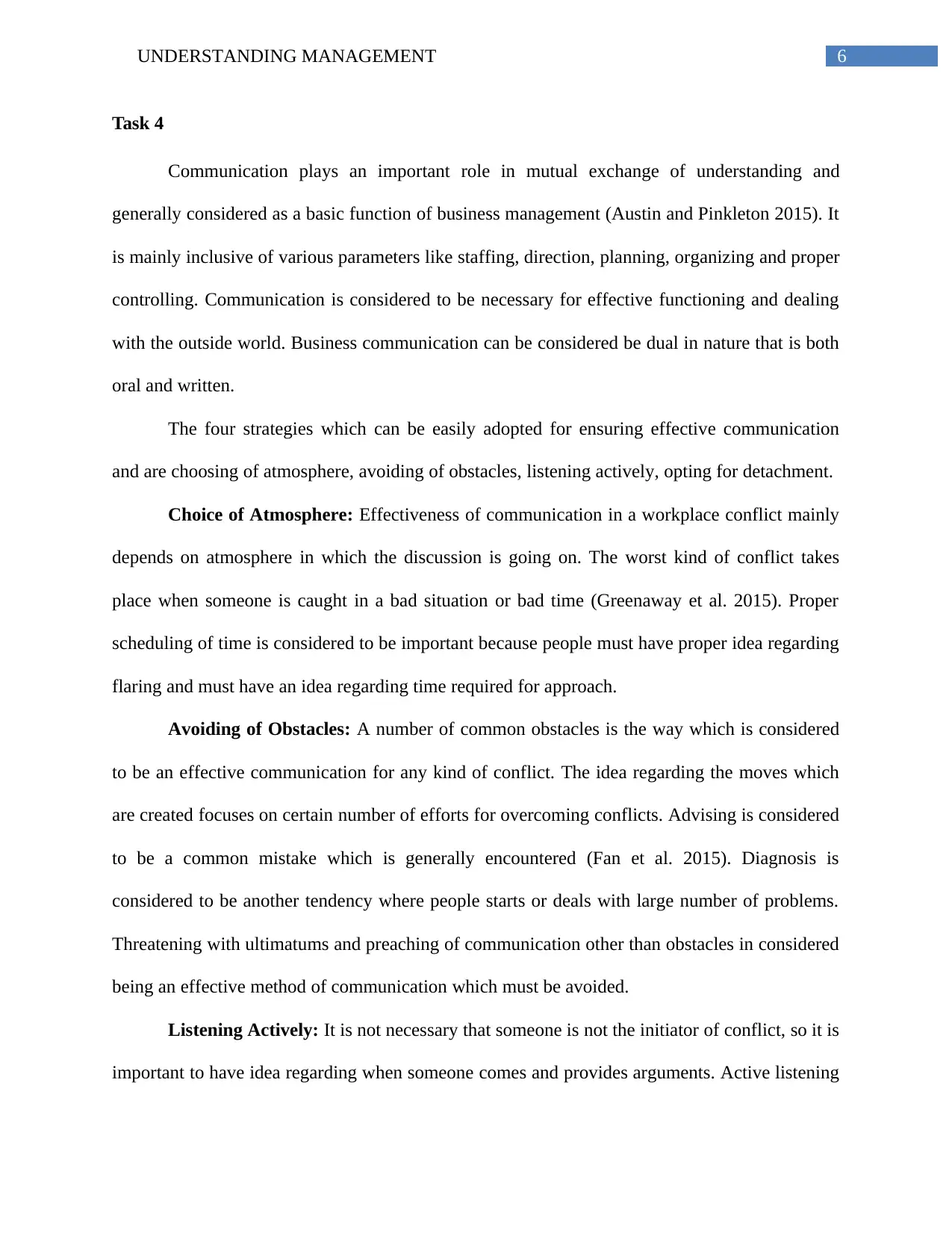
6UNDERSTANDING MANAGEMENT
Task 4
Communication plays an important role in mutual exchange of understanding and
generally considered as a basic function of business management (Austin and Pinkleton 2015). It
is mainly inclusive of various parameters like staffing, direction, planning, organizing and proper
controlling. Communication is considered to be necessary for effective functioning and dealing
with the outside world. Business communication can be considered be dual in nature that is both
oral and written.
The four strategies which can be easily adopted for ensuring effective communication
and are choosing of atmosphere, avoiding of obstacles, listening actively, opting for detachment.
Choice of Atmosphere: Effectiveness of communication in a workplace conflict mainly
depends on atmosphere in which the discussion is going on. The worst kind of conflict takes
place when someone is caught in a bad situation or bad time (Greenaway et al. 2015). Proper
scheduling of time is considered to be important because people must have proper idea regarding
flaring and must have an idea regarding time required for approach.
Avoiding of Obstacles: A number of common obstacles is the way which is considered
to be an effective communication for any kind of conflict. The idea regarding the moves which
are created focuses on certain number of efforts for overcoming conflicts. Advising is considered
to be a common mistake which is generally encountered (Fan et al. 2015). Diagnosis is
considered to be another tendency where people starts or deals with large number of problems.
Threatening with ultimatums and preaching of communication other than obstacles in considered
being an effective method of communication which must be avoided.
Listening Actively: It is not necessary that someone is not the initiator of conflict, so it is
important to have idea regarding when someone comes and provides arguments. Active listening
Task 4
Communication plays an important role in mutual exchange of understanding and
generally considered as a basic function of business management (Austin and Pinkleton 2015). It
is mainly inclusive of various parameters like staffing, direction, planning, organizing and proper
controlling. Communication is considered to be necessary for effective functioning and dealing
with the outside world. Business communication can be considered be dual in nature that is both
oral and written.
The four strategies which can be easily adopted for ensuring effective communication
and are choosing of atmosphere, avoiding of obstacles, listening actively, opting for detachment.
Choice of Atmosphere: Effectiveness of communication in a workplace conflict mainly
depends on atmosphere in which the discussion is going on. The worst kind of conflict takes
place when someone is caught in a bad situation or bad time (Greenaway et al. 2015). Proper
scheduling of time is considered to be important because people must have proper idea regarding
flaring and must have an idea regarding time required for approach.
Avoiding of Obstacles: A number of common obstacles is the way which is considered
to be an effective communication for any kind of conflict. The idea regarding the moves which
are created focuses on certain number of efforts for overcoming conflicts. Advising is considered
to be a common mistake which is generally encountered (Fan et al. 2015). Diagnosis is
considered to be another tendency where people starts or deals with large number of problems.
Threatening with ultimatums and preaching of communication other than obstacles in considered
being an effective method of communication which must be avoided.
Listening Actively: It is not necessary that someone is not the initiator of conflict, so it is
important to have idea regarding when someone comes and provides arguments. Active listening
Paraphrase This Document
Need a fresh take? Get an instant paraphrase of this document with our AI Paraphraser

7UNDERSTANDING MANAGEMENT
is considered is generally considered to best method for managing various kinds of conflicts.
Proper displaying of willingness to hear concern will help in managing various kinds of conflict
(Fan et al. 2015). Interest can be easily shown by making eye contact, nodding in agreement and
asking right number of questions.
Opting for Detachment: The best way for dealing with co-worker is to ignore various
kinds of irate co-worker and detaching from them. In some cases, it is seen that it is adventurous
is to supervisor rather than dealing with the problem yourself. The execution if done in a right
way, a light-hearted detachment can easily take away some of the tensions (Austin and Pinkleton
2015). Making use of distractions can easily add advantage to changing topic when various
things get heated.
is considered is generally considered to best method for managing various kinds of conflicts.
Proper displaying of willingness to hear concern will help in managing various kinds of conflict
(Fan et al. 2015). Interest can be easily shown by making eye contact, nodding in agreement and
asking right number of questions.
Opting for Detachment: The best way for dealing with co-worker is to ignore various
kinds of irate co-worker and detaching from them. In some cases, it is seen that it is adventurous
is to supervisor rather than dealing with the problem yourself. The execution if done in a right
way, a light-hearted detachment can easily take away some of the tensions (Austin and Pinkleton
2015). Making use of distractions can easily add advantage to changing topic when various
things get heated.

8UNDERSTANDING MANAGEMENT
References
Albrecht, S.L., Bakker, A.B., Gruman, J.A., Macey, W.H. and Saks, A.M., 2015. Employee
engagement, human resource management practices and competitive advantage: An integrated
approach. Journal of Organizational Effectiveness: People and Performance, 2(1), pp.7-35.
Austin, E.W. and Pinkleton, B.E., 2015. Strategic public relations management: Planning and
managing effective communication campaigns (Vol. 10). Routledge.
Birkinshaw, J. and Ansari, S., 2015. Understanding Management Models. Going Beyond" What"
and" Why" to" How" Work Gets Done in Organizations. Foss, JN, & Saebi, pp.85-103.
Fan, S.P., Liberman, Z., Keysar, B. and Kinzler, K.D., 2015. The exposure advantage: Early
exposure to a multilingual environment promotes effective communication. Psychological
Science, 26(7), pp.1090-1097.
Gond, J.P., Cabantous, L., Harding, N. and Learmonth, M., 2016. What do we mean by
performativity in organizational and management theory? The uses and abuses of
performativity. International Journal of Management Reviews, 18(4), pp.440-463.
Greenaway, K.H., Wright, R.G., Willingham, J., Reynolds, K.J. and Haslam, S.A., 2015. Shared
identity is key to effective communication. Personality and Social Psychology Bulletin, 41(2),
pp.171-182
Hill, C.W., Jones, G.R. and Schilling, M.A., 2014. Strategic management: theory: an integrated
approach. Cengage Learning.
Kerzner, H. and Kerzner, H.R., 2017. Project management: a systems approach to planning,
scheduling, and controlling. John Wiley & Sons.
Morris, J.P., 2017. What is the cultural web of an academy? An investigation into one academy’s
organisational culture(Doctoral dissertation, University of Birmingham).
References
Albrecht, S.L., Bakker, A.B., Gruman, J.A., Macey, W.H. and Saks, A.M., 2015. Employee
engagement, human resource management practices and competitive advantage: An integrated
approach. Journal of Organizational Effectiveness: People and Performance, 2(1), pp.7-35.
Austin, E.W. and Pinkleton, B.E., 2015. Strategic public relations management: Planning and
managing effective communication campaigns (Vol. 10). Routledge.
Birkinshaw, J. and Ansari, S., 2015. Understanding Management Models. Going Beyond" What"
and" Why" to" How" Work Gets Done in Organizations. Foss, JN, & Saebi, pp.85-103.
Fan, S.P., Liberman, Z., Keysar, B. and Kinzler, K.D., 2015. The exposure advantage: Early
exposure to a multilingual environment promotes effective communication. Psychological
Science, 26(7), pp.1090-1097.
Gond, J.P., Cabantous, L., Harding, N. and Learmonth, M., 2016. What do we mean by
performativity in organizational and management theory? The uses and abuses of
performativity. International Journal of Management Reviews, 18(4), pp.440-463.
Greenaway, K.H., Wright, R.G., Willingham, J., Reynolds, K.J. and Haslam, S.A., 2015. Shared
identity is key to effective communication. Personality and Social Psychology Bulletin, 41(2),
pp.171-182
Hill, C.W., Jones, G.R. and Schilling, M.A., 2014. Strategic management: theory: an integrated
approach. Cengage Learning.
Kerzner, H. and Kerzner, H.R., 2017. Project management: a systems approach to planning,
scheduling, and controlling. John Wiley & Sons.
Morris, J.P., 2017. What is the cultural web of an academy? An investigation into one academy’s
organisational culture(Doctoral dissertation, University of Birmingham).
⊘ This is a preview!⊘
Do you want full access?
Subscribe today to unlock all pages.

Trusted by 1+ million students worldwide
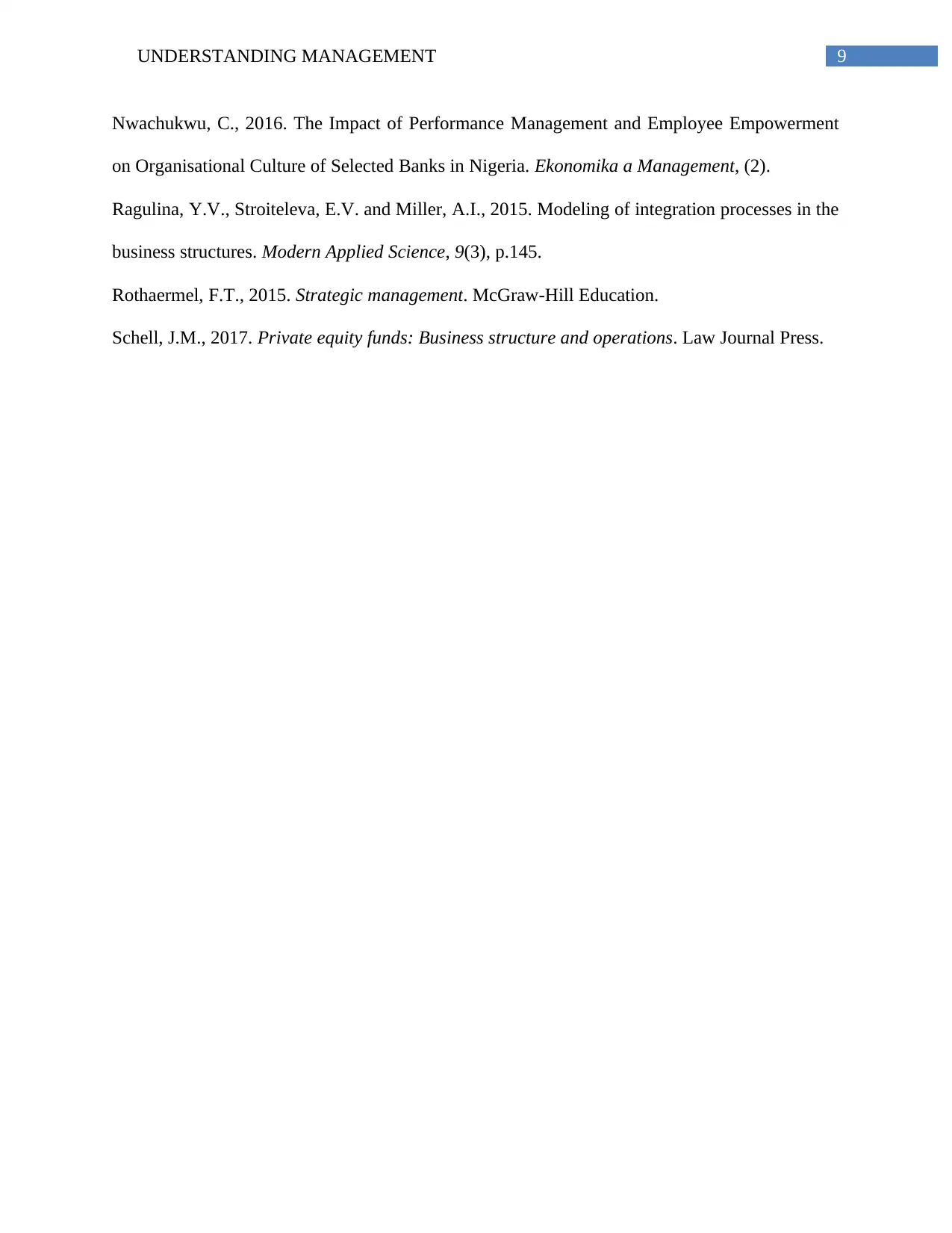
9UNDERSTANDING MANAGEMENT
Nwachukwu, C., 2016. The Impact of Performance Management and Employee Empowerment
on Organisational Culture of Selected Banks in Nigeria. Ekonomika a Management, (2).
Ragulina, Y.V., Stroiteleva, E.V. and Miller, A.I., 2015. Modeling of integration processes in the
business structures. Modern Applied Science, 9(3), p.145.
Rothaermel, F.T., 2015. Strategic management. McGraw-Hill Education.
Schell, J.M., 2017. Private equity funds: Business structure and operations. Law Journal Press.
Nwachukwu, C., 2016. The Impact of Performance Management and Employee Empowerment
on Organisational Culture of Selected Banks in Nigeria. Ekonomika a Management, (2).
Ragulina, Y.V., Stroiteleva, E.V. and Miller, A.I., 2015. Modeling of integration processes in the
business structures. Modern Applied Science, 9(3), p.145.
Rothaermel, F.T., 2015. Strategic management. McGraw-Hill Education.
Schell, J.M., 2017. Private equity funds: Business structure and operations. Law Journal Press.
1 out of 10
Related Documents
Your All-in-One AI-Powered Toolkit for Academic Success.
+13062052269
info@desklib.com
Available 24*7 on WhatsApp / Email
![[object Object]](/_next/static/media/star-bottom.7253800d.svg)
Unlock your academic potential
Copyright © 2020–2025 A2Z Services. All Rights Reserved. Developed and managed by ZUCOL.





